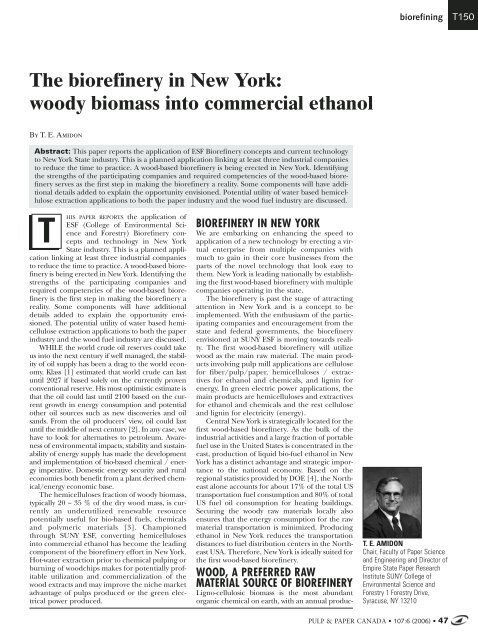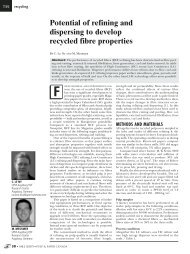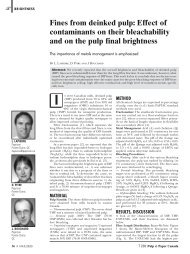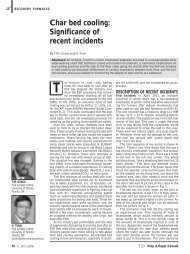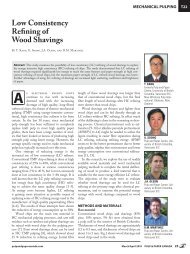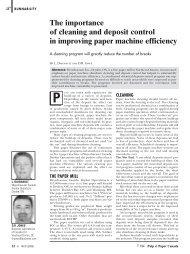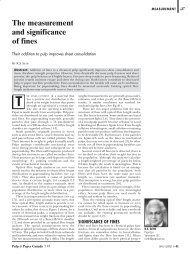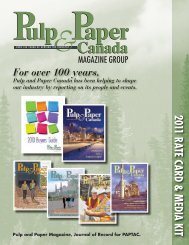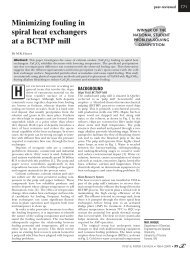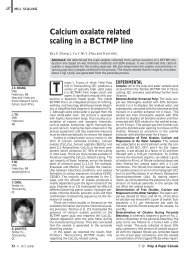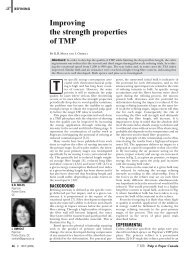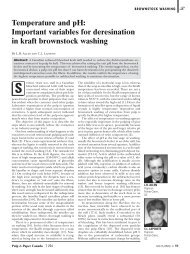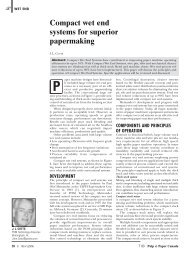The biorefinery in New York: woody biomass into commercial ethanol
The biorefinery in New York: woody biomass into commercial ethanol
The biorefinery in New York: woody biomass into commercial ethanol
You also want an ePaper? Increase the reach of your titles
YUMPU automatically turns print PDFs into web optimized ePapers that Google loves.
ioref<strong>in</strong><strong>in</strong>gT150<strong>The</strong> <strong>bioref<strong>in</strong>ery</strong> <strong>in</strong> <strong>New</strong> <strong>York</strong>:<strong>woody</strong> <strong>biomass</strong> <strong>in</strong>to <strong>commercial</strong> <strong>ethanol</strong>By T. E. AmidonAbstract: This paper reports the application of ESF Bioref<strong>in</strong>ery concepts and current technologyto <strong>New</strong> <strong>York</strong> State <strong>in</strong>dustry. This is a planned application l<strong>in</strong>k<strong>in</strong>g at least three <strong>in</strong>dustrial companiesto reduce the time to practice. A wood-based <strong>bioref<strong>in</strong>ery</strong> is be<strong>in</strong>g erected <strong>in</strong> <strong>New</strong> <strong>York</strong>. Identify<strong>in</strong>gthe strengths of the participat<strong>in</strong>g companies and required competencies of the wood-based <strong>bioref<strong>in</strong>ery</strong>serves as the first step <strong>in</strong> mak<strong>in</strong>g the <strong>bioref<strong>in</strong>ery</strong> a reality. Some components will have additionaldetails added to expla<strong>in</strong> the opportunity envisioned. Potential utility of water based hemicelluloseextraction applications to both the paper <strong>in</strong>dustry and the wood fuel <strong>in</strong>dustry are discussed.THIS PAPER REPORTS the application ofESF (College of Environmental Scienceand Forestry) Bioref<strong>in</strong>ery conceptsand technology <strong>in</strong> <strong>New</strong> <strong>York</strong>State <strong>in</strong>dustry. This is a planned applicationl<strong>in</strong>k<strong>in</strong>g at least three <strong>in</strong>dustrial companiesto reduce the time to practice. A wood-based <strong>bioref<strong>in</strong>ery</strong>is be<strong>in</strong>g erected <strong>in</strong> <strong>New</strong> <strong>York</strong>. Identify<strong>in</strong>g thestrengths of the participat<strong>in</strong>g companies andrequired competencies of the wood-based <strong>bioref<strong>in</strong>ery</strong>is the first step <strong>in</strong> mak<strong>in</strong>g the <strong>bioref<strong>in</strong>ery</strong> areality. Some components will have additionaldetails added to expla<strong>in</strong> the opportunity envisioned.<strong>The</strong> potential utility of water based hemicelluloseextraction applications to both the paper<strong>in</strong>dustry and the wood fuel <strong>in</strong>dustry are discussed.WHILE the world crude oil reserves could takeus <strong>in</strong>to the next century if well managed, the stabilityof oil supply has been a drag to the world economy.Klass [1] estimated that world crude can lastuntil 2027 if based solely on the currently provenconventional reserve. His most optimistic estimate isthat the oil could last until 2100 based on the currentgrowth <strong>in</strong> energy consumption and potentialother oil sources such as new discoveries and oilsands. From the oil producers’ view, oil could lastuntil the middle of next century [2]. In any case, wehave to look for alternatives to petroleum. Awarenessof environmental impacts, stability and susta<strong>in</strong>abilityof energy supply has made the developmentand implementation of bio-based chemical / energyimperative. Domestic energy security and ruraleconomies both benefit from a plant derived chemical/energyeconomic base.<strong>The</strong> hemicelluloses fraction of <strong>woody</strong> <strong>biomass</strong>,typically 20 ~ 35 % of the dry wood mass, is currentlyan underutilized renewable resourcepotentially useful for bio-based fuels, chemicalsand polymeric materials [3]. Championedthrough SUNY ESF, convert<strong>in</strong>g hemicelluloses<strong>in</strong>to <strong>commercial</strong> <strong>ethanol</strong> has become the lead<strong>in</strong>gcomponent of the <strong>bioref<strong>in</strong>ery</strong> effort <strong>in</strong> <strong>New</strong> <strong>York</strong>.Hot-water extraction prior to chemical pulp<strong>in</strong>g orburn<strong>in</strong>g of woodchips makes for potentially profitableutilization and <strong>commercial</strong>ization of thewood extracts and may improve the niche marketadvantage of pulps produced or the green electricalpower produced.BIOREFINERY IN NEW YORKWe are embark<strong>in</strong>g on enhanc<strong>in</strong>g the speed toapplication of a new technology by erect<strong>in</strong>g a virtualenterprise from multiple companies withmuch to ga<strong>in</strong> <strong>in</strong> their core bus<strong>in</strong>esses from theparts of the novel technology that look easy tothem. <strong>New</strong> <strong>York</strong> is lead<strong>in</strong>g nationally by establish<strong>in</strong>gthe first wood-based <strong>bioref<strong>in</strong>ery</strong> with multiplecompanies operat<strong>in</strong>g <strong>in</strong> the state.<strong>The</strong> <strong>bioref<strong>in</strong>ery</strong> is past the stage of attract<strong>in</strong>gattention <strong>in</strong> <strong>New</strong> <strong>York</strong> and is a concept to beimplemented. With the enthusiasm of the participat<strong>in</strong>gcompanies and encouragement from thestate and federal governments, the <strong>bioref<strong>in</strong>ery</strong>envisioned at SUNY ESF is mov<strong>in</strong>g towards reality.<strong>The</strong> first wood-based <strong>bioref<strong>in</strong>ery</strong> will utilizewood as the ma<strong>in</strong> raw material. <strong>The</strong> ma<strong>in</strong> products<strong>in</strong>volv<strong>in</strong>g pulp mill applications are cellulosefor fiber/pulp/paper, hemicelluloses / extractivesfor <strong>ethanol</strong> and chemicals, and lign<strong>in</strong> forenergy. In green electric power applications, thema<strong>in</strong> products are hemicelluloses and extractivesfor <strong>ethanol</strong> and chemicals and the rest celluloseand lign<strong>in</strong> for electricity (energy).Central <strong>New</strong> <strong>York</strong> is strategically located for thefirst wood-based <strong>bioref<strong>in</strong>ery</strong>. As the bulk of the<strong>in</strong>dustrial activities and a large fraction of portablefuel use <strong>in</strong> the United States is concentrated <strong>in</strong> theeast, production of liquid bio-fuel <strong>ethanol</strong> <strong>in</strong> <strong>New</strong><strong>York</strong> has a dist<strong>in</strong>ct advantage and strategic importanceto the national economy. Based on theregional statistics provided by DOE [4], the Northeastalone accounts for about 17% of the total UStransportation fuel consumption and 80% of totalUS fuel oil consumption for heat<strong>in</strong>g build<strong>in</strong>gs.Secur<strong>in</strong>g the <strong>woody</strong> raw materials locally alsoensures that the energy consumption for the rawmaterial transportation is m<strong>in</strong>imized. Produc<strong>in</strong>g<strong>ethanol</strong> <strong>in</strong> <strong>New</strong> <strong>York</strong> reduces the transportationdistances to fuel distribution centers <strong>in</strong> the NortheastUSA. <strong>The</strong>refore, <strong>New</strong> <strong>York</strong> is ideally suited forthe first wood-based <strong>bioref<strong>in</strong>ery</strong>.WOOD, A PREFERRED RAWMATERIAL SOURCE OF BIOREFINERYLigno-cellulosic <strong>biomass</strong> is the most abundantorganic chemical on earth, with an annual produc-T. E. AMIDONChair, Faculty of Paper Scienceand Eng<strong>in</strong>eer<strong>in</strong>g and Director ofEmpire State Paper ResearchInstitute SUNY College ofEnvironmental Science andForestry 1 Forestry Drive,Syracuse, NY 13210PULP & PAPER CANADA • 107:6 (2006) • 47
T151bioref<strong>in</strong><strong>in</strong>gtion <strong>in</strong> the biosphere of about 170 billionmetric tons [1]. Forests account for 42.9%of the annual carbon production andSavanna and grasses account for 11% oftotal <strong>biomass</strong> production. When measured<strong>in</strong> energy terms, the amount of carbon synthesizedby plants is equivalent to about tentimes the world’s total energy consumptionof 323 EJ [1]. Dedicated energy crops: agriforestand/or agriculture <strong>biomass</strong> can further<strong>in</strong>crease the <strong>biomass</strong> availability.Renewable forest material is carbonneutral, i.e. utiliz<strong>in</strong>g forest material willnot create a carbon imbalance over anextended (5 ~ 50 years [5]) time frame.Utiliz<strong>in</strong>g renewable carbon (as illustrated<strong>in</strong> the Figure 1) elim<strong>in</strong>ates an additionalcarbon dioxide burden to the environmentand thus acts favorably to reduceCO 2 emissions and, therefore, to GHGdriven global climate change. <strong>The</strong>refore,managed forests have significant potentialto reduce green-house gas emissions byconversion of the forest material <strong>in</strong>to liquidfuels, electricity and other productsnow be<strong>in</strong>g derived from nonrenewablecarbon. While agriculture crops andperennial grasses are annually renewableand thus more efficient <strong>in</strong> carbonturnover (by a factor of 5 ~ 50 thanwood), they are seasonal <strong>in</strong> nature. Woodresource availability is little affected byseasons and thus is a preferred resourcefor cont<strong>in</strong>uous <strong>in</strong>dustrial operations.Us<strong>in</strong>g the forest as the resource for an<strong>in</strong>dustrial base is not new.“... forests can be made to produce fiftytimes their present volume of end productsand still rema<strong>in</strong> a permanently selfrenew<strong>in</strong>gsource for raw materials....Only forests - no other raw materialresource can yield such returns. <strong>The</strong> forestcan, and so must, end the chronicscarcities of material goods that haveharassed man’s experience s<strong>in</strong>ce thebeg<strong>in</strong>n<strong>in</strong>g of history.” From <strong>The</strong> Com<strong>in</strong>g Ageof Wood, by Egon Gles<strong>in</strong>ger, 1949 [6].Putt<strong>in</strong>g Egon Gles<strong>in</strong>ger’s vision <strong>in</strong>toaction is still a work <strong>in</strong> progress and thispaper presents another developmentalstep.Develop<strong>in</strong>g a <strong>bioref<strong>in</strong>ery</strong> technologybased on wood is imperative to the developmentof a bio-based energy economy,whether the f<strong>in</strong>al <strong>in</strong>tent is the use of forest<strong>biomass</strong>, <strong>woody</strong> <strong>biomass</strong> crops, perennialgrasses, or agricultural residues, all ofwhich are beneficial to the rural economy.Many studies have been done on cerealstraw pulps, for example. It has beenfound that a green field wheat straw pulpmill is not economically feasible [7]. Onthe other hand, if a straw pulp l<strong>in</strong>e isadded to an exist<strong>in</strong>g pulp mill, the feasibilityimproves significantly [7], based onthe facility requirement alone. When oneconsiders the seasonality effect or fibersecurity, the <strong>in</strong>tegration of an agricultureresidual facility with an exist<strong>in</strong>g pulp millbecomes more critical. <strong>The</strong>refore, develop<strong>in</strong>gbioref<strong>in</strong><strong>in</strong>g technology based onwood is an important step <strong>in</strong> the <strong>in</strong>dustrialimplementation of a bio-based technologyfor many <strong>biomass</strong> sources.In addition to the clear advantage ofwood as <strong>biomass</strong> resource, the U.S. Northeasthas abundant forest resources currentlyavailable. Through the promotionof wood as a raw material for a <strong>bioref<strong>in</strong>ery</strong>we can encourage healthy forestry practicesas well. Companies are motivated bytheir economic needs and ability to ma<strong>in</strong>ta<strong>in</strong>the forests as healthy and productiveand the development of an outlet for lowergrade <strong>biomass</strong> wood can permit timberstand improvement operations that wouldof otherwise be uneconomic.WOOD-BASED BIOREFINERYCOMPETENCE REQUIREMENTS<strong>The</strong> Twenty-First century is envisioned tobecome the “age of biology” as susta<strong>in</strong>able<strong>biomass</strong> resources replace non-renewablepetroleum <strong>in</strong> energy and <strong>in</strong>dustrial productapplications [8, 9]. Motivated by concernsover national energy security, globalCO 2 emission reduction, an evolv<strong>in</strong>g needfor biodegradable products, andenhanced rural economic development,the eng<strong>in</strong>eer<strong>in</strong>g and construction of“bioref<strong>in</strong>eries” is now a critical nationalpriority. Wood is the preferred raw material.<strong>The</strong> vision of a “wood-based” <strong>bioref<strong>in</strong>ery</strong>becom<strong>in</strong>g a <strong>commercial</strong> reality willrequire the follow<strong>in</strong>g core competencies:1) Development of fast-grow<strong>in</strong>g <strong>woody</strong>species that can be used year-round as the<strong>bioref<strong>in</strong>ery</strong> feedstock. <strong>The</strong>se feedstocksshould enjoy “life cycle” energy benefitscompared to alternative <strong>biomass</strong>resources such as dedicated agriculturalcrops and offer cont<strong>in</strong>uity over agriculturalresidues.2) Efficient pretreatment and separationscenarios for <strong>woody</strong> <strong>biomass</strong> that provideat least three major process streams forthe <strong>bioref<strong>in</strong>ery</strong>: cellulose, hemicellulosesand lign<strong>in</strong>.3) Creation of a value-added portfolio offuels, chemicals, and materials from eachof the three bioref<strong>in</strong><strong>in</strong>ery process streamsthat mimic the diverse product slate characteristicof today’s petroleum ref<strong>in</strong>eries.Although cellulose fiber is profitablyexploited by the paper <strong>in</strong>dustry, the hemicellulosesand lign<strong>in</strong> components of woodare generally underutilized.At SUNY ESF, we have been activelyengaged <strong>in</strong> develop<strong>in</strong>g the competenciesand fill<strong>in</strong>g the gaps between the <strong>commercial</strong><strong>bioref<strong>in</strong>ery</strong> and technology requirements.<strong>The</strong> learn<strong>in</strong>g has currently beentaken to bench and pilot scale and we areplann<strong>in</strong>g the <strong>in</strong>dustrial scale applicationsthat this paper presents. <strong>The</strong> currentprogress proposed for application is aresult of work from more than 12 facultymembers <strong>in</strong> four different faculties/departments at ESF. <strong>The</strong> research supporthas been provided by the Empire StateFIG. 1. Schematic of chemicals andenergy from renewable feedstock.Paper Research Institute (ESPRI) and thef<strong>in</strong>ancial support for some of the pilotplant work has been provided by the VPP(Value Prior to Pulp) consortium of eightcompanies from the AF&PA.MATCHING CHALLENGESWITH EXPERTISESuccess of the <strong>bioref<strong>in</strong>ery</strong> will rely on thecompetencies of participat<strong>in</strong>g companiesand <strong>in</strong>dividuals to match the operationalrequirements of a forest based <strong>bioref<strong>in</strong>ery</strong>.S<strong>in</strong>ce the <strong>in</strong>ception of the hot-water basedwood <strong>bioref<strong>in</strong>ery</strong> concept at SUNY ESF, wehave been work<strong>in</strong>g towards the reality ofsuch a <strong>bioref<strong>in</strong>ery</strong> process application. <strong>The</strong>challenges and competencies are matchedto companies or <strong>in</strong>dustry sectors that caneasily adapt to the process requirements, ifthey are not already possessed, to ensure ahigh probability of success:1) <strong>The</strong> competencies <strong>in</strong> wood grow<strong>in</strong>g,procurement, chipp<strong>in</strong>g / pretreatment,chemical process<strong>in</strong>g are found <strong>in</strong> thePulp and Paper Industry;2) <strong>The</strong> competencies of willow <strong>biomass</strong>grow<strong>in</strong>g, harvest<strong>in</strong>g and burn<strong>in</strong>g arefound among Farmers and <strong>in</strong> the WoodFuel Industry;3) <strong>The</strong> competencies of fermentation ofsugars to products and market<strong>in</strong>g arefound <strong>in</strong> the Ethanol Industry.<strong>The</strong>se matches between needs andcompetencies are found <strong>in</strong> <strong>New</strong> <strong>York</strong>:1) Conventional Wood Process<strong>in</strong>g forPulp and Paper <strong>in</strong> Ticonderoga, <strong>New</strong><strong>York</strong>;2) Biomass Willow grow<strong>in</strong>g and burn<strong>in</strong>g -<strong>New</strong> <strong>York</strong> Field Trials <strong>in</strong> Tully, <strong>New</strong> <strong>York</strong>and Lyon Falls, <strong>New</strong> <strong>York</strong>;3) Fermentation of sugars to productsand market<strong>in</strong>g <strong>in</strong> Fulton, <strong>New</strong> <strong>York</strong> at theNortheast Biofuels facility.<strong>The</strong> match of expertise from each participat<strong>in</strong>gcompany reflects the majorobjectives of the first wood-based <strong>bioref<strong>in</strong>ery</strong>:cellulose for fiber/pulp/paper,hemicelluloses / extractives for <strong>ethanol</strong>and chemicals, and lign<strong>in</strong> for energy [10].In the green electrical power case the celluloseand lign<strong>in</strong> are both used for energy.Locat<strong>in</strong>g the companies / facilities thatmatch the required competencies of awood <strong>bioref<strong>in</strong>ery</strong> completes the first steptoward erect<strong>in</strong>g the first wood-based<strong>bioref<strong>in</strong>ery</strong> <strong>in</strong> <strong>New</strong> <strong>York</strong>.48 • 107:6 (2006) • PULP & PAPER CANADA
ioref<strong>in</strong><strong>in</strong>gT152PLAN OF ACTIONWith the required competencies identified,the companies are coord<strong>in</strong>ated toerect the first wood-based <strong>bioref<strong>in</strong>ery</strong> <strong>in</strong><strong>New</strong> <strong>York</strong>. <strong>The</strong> reality of the SUNY ESFstyle <strong>bioref<strong>in</strong>ery</strong> is well under its way ofimplementation. <strong>The</strong> follow<strong>in</strong>g actionsare scheduled for immediate implementation<strong>in</strong> 2006:1) Extraction and separation of woodsugars at ESF pilot, Syracuse, <strong>New</strong> <strong>York</strong>;2) Burn<strong>in</strong>g of extracted wood at Lyonsdale,<strong>New</strong> <strong>York</strong>;3) Ethanol from wood sugars at ESF Pilot,Syracuse, <strong>New</strong> <strong>York</strong>;4) Northeast Biofuels reconfigurationbegun, Fulton, <strong>New</strong> <strong>York</strong>.And <strong>in</strong> the com<strong>in</strong>g two years, implement<strong>in</strong>g5) Extraction and separation of woodsugars at Ticonderoga, <strong>New</strong> <strong>York</strong>;6) Burn<strong>in</strong>g of extracted wood at Lyonsdale,<strong>New</strong> <strong>York</strong>;7) Pilot scale <strong>ethanol</strong> from wood sugarsat Northeast Biofuels, Fulton, <strong>New</strong> <strong>York</strong>.And <strong>in</strong> the third year8) Commercial scale extraction and separationof wood sugars at Ticonderoga, <strong>New</strong><strong>York</strong> and shipp<strong>in</strong>g to Fulton, <strong>New</strong> <strong>York</strong>;9) Commercial extraction and burn<strong>in</strong>g atLyonsdale, <strong>New</strong> <strong>York</strong> and shipp<strong>in</strong>g woodsugars to Fulton, <strong>New</strong> <strong>York</strong>;10) Ethanol from Ticonderoga andLyonsdale Wood Sugars produced atNortheast Biofuels, Fulton, <strong>New</strong> <strong>York</strong>.<strong>The</strong> plan has been set <strong>in</strong> motion by allthe participat<strong>in</strong>g partners who see economicbenefit <strong>in</strong> their bus<strong>in</strong>ess models.This development will be a success as longas each company cont<strong>in</strong>ues to see theimportance <strong>in</strong> their profitability. Whilethere is a penalty of added cost due to thetransportation of sugars from the extractionsites to the <strong>ethanol</strong> production site,the unique “three sites” approach is chosenfor a speedy implementation of thefirst wood-based <strong>bioref<strong>in</strong>ery</strong>. <strong>The</strong> risks areshared among the participants and thecompetencies are matched to m<strong>in</strong>imizethe risk at each site. <strong>The</strong> experiencelearned from the “three sites” can beadapted to improve the overall “structure”and each site is prepared to implement an“<strong>in</strong>dependent” wood-based <strong>bioref<strong>in</strong>ery</strong>.WHY BIOREFINERY NOWTable 1 shows the national targets set byNRC for the bio-based products <strong>in</strong> theUnited States of America. While most liquidfuels and chemicals are currently notbio-based, a dramatic <strong>in</strong>crease is be<strong>in</strong>gpursued. To meet the national targets, wemust beg<strong>in</strong> act<strong>in</strong>g today to secure the successof the bio-based <strong>in</strong>dustry.To lessen the nation’s dependence onpetroleum, bio- or plant-based chemicaland fuel <strong>in</strong>dustries must be quickly begunso that the evolution of an <strong>in</strong>tegrated biobased<strong>in</strong>dustry can be accomplished whileTABLE I. Estimated current levels and targets for a national bio-based <strong>in</strong>dustry [8].Bio-Product Current 2020 2090Liquid Fuels 1-2% 10% 50%Chemicals 10% 25% >90%Materials 90 % 95% 99%Based on NRC Report - 2000it is still possible without resort<strong>in</strong>g to crisisdriven actions. This urgent need to beg<strong>in</strong>has been the ma<strong>in</strong> driver for the speedyimplementation of the ESF wood-based<strong>bioref<strong>in</strong>ery</strong>.WHY - PAPER INDUSTRY<strong>The</strong> <strong>in</strong>volvement of the paper <strong>in</strong>dustry <strong>in</strong>the <strong>bioref<strong>in</strong>ery</strong> is not only for nationalenergy security strategic reasons, but forthe success and survival of the <strong>in</strong>dustry aswell. Traditionally, the paper <strong>in</strong>dustry utilizescellulose for paper and lign<strong>in</strong> forenergy. Despite the comb<strong>in</strong>ation of paperand energy, the paper <strong>in</strong>dustry has hadlow profitability for over 15 years. <strong>The</strong>paper <strong>in</strong>dustry must look to other <strong>in</strong>itiativesto change the overall profitabilityand enhance their ability to survive.<strong>The</strong> Kraft process is the most widelyused chemical pulp<strong>in</strong>g technology utiliz<strong>in</strong>gwood. Up to 20% of wood weight, <strong>in</strong> theform of hemicelluloses, is removed fromthe fibers dur<strong>in</strong>g Kraft cook<strong>in</strong>g. <strong>The</strong>degraded hemicelluloses, <strong>in</strong> the blackliquor, have a heat<strong>in</strong>g value of 13.6 MJ / kgwhich is about half that of lign<strong>in</strong> at 25 MJ/ kg [11]. <strong>The</strong>refore, a potentially highervalue use of hemicelluloses would be toextract them as monomers or oligomersprior to pulp<strong>in</strong>g, followed by conversion tohigher value-added products such as<strong>ethanol</strong>, polymers and chemicals.By <strong>in</strong>sert<strong>in</strong>g a new process <strong>in</strong> front ofthe digester to extract hemicelluloses,which can then be converted to <strong>ethanol</strong>,PHA’s, and other bioproducts, and recover<strong>in</strong>gacetic acid, one can enhance theoverall energy efficiency of the kraft process.<strong>The</strong> estimated profit <strong>in</strong>crease for acomplete paper <strong>in</strong>dustry application is$3.3 Billion per year [12]. Total productionwas estimated at 1.9 Billon gallons of<strong>ethanol</strong> and 600 Million gallons of aceticacid can be produced for an <strong>in</strong>dustry-wideapplication [12].WHY - WOOD BURNINGINDUSTRY<strong>The</strong> wood burn<strong>in</strong>g <strong>in</strong>dustry has marg<strong>in</strong>aleconomics and only the lowest cost andquality wood is affordable. Evolutionarychange is possible <strong>in</strong> the wood burn<strong>in</strong>g<strong>in</strong>dustry us<strong>in</strong>g the SUNY ESF <strong>bioref<strong>in</strong>ery</strong>concept. Wood costs presently range fromapproximately $40 to $ 80 per dry ton, or$0.02 - $0.04 / dry pound. Extraction canbe achieved at 15% of mass recoveredwith two thirds as wood sugars and therema<strong>in</strong><strong>in</strong>g one third as acetic acid/extrac-tives. Presently, sugars can be priced at am<strong>in</strong>imum of $0.07 / pound and aceticacid / extractives at $0.30 / pound, whichrenders $0.07 2 ⁄3 + $0.30 1 ⁄3 = $ 0.146per pound for the mass recovered. <strong>The</strong>extraction produces value for the 300pounds recovered from one ton of woodat $43.80 which equates to half to all ofthe wood cost. <strong>The</strong>refore, the residue canbe then burned with cost reduction that islikely to be greater than the mass lost.WHY - WOOD SUGARETHANOL PRODUCTIONIN FULTON NEW YORKWhile corn has been the current choicefor <strong>ethanol</strong> <strong>in</strong> the U.S.A., there is limitedsupply <strong>in</strong> <strong>New</strong> <strong>York</strong>. <strong>The</strong> limited productionof corn <strong>in</strong> <strong>New</strong> <strong>York</strong> is largely dedicatedto dairy use. Most commodity cornis shipped from the American Mid-West.<strong>The</strong>refore, local corn is limited as rawmaterial for <strong>ethanol</strong> <strong>in</strong> <strong>New</strong> <strong>York</strong> andmuch of the corn to be used has a significanttransportation cost to be absorbed.Corn market price fluctuations are aserious bus<strong>in</strong>ess risk for corn based <strong>ethanol</strong><strong>in</strong> <strong>New</strong> <strong>York</strong>, particularly with the <strong>in</strong>crementaltransportation cost needed. Sugarsource diversification has beneficial shortterm and long term impact on the bus<strong>in</strong>essmodel. Wood sugars that are producedfrom locally grown <strong>woody</strong> feed stocks areprojected to be lower <strong>in</strong> cost. <strong>The</strong> forestryorig<strong>in</strong>ated sugars are free-from seasonaleffects and can provide buffer<strong>in</strong>g for cyclicannual growth events <strong>in</strong> agriculturallyderived sugars. Near Fulton, there areabundant low cost hardwood forests <strong>in</strong> theadjacent Tug Hill Plateau and excellent<strong>biomass</strong> willow grow<strong>in</strong>g potential on theLake Ontario Pla<strong>in</strong>s. <strong>The</strong>refore, woodderived sugars are natural complement forcorn derived sugars for <strong>ethanol</strong> productionat Fulton, <strong>New</strong> <strong>York</strong>.PLAYERSS<strong>in</strong>ce the concept of a <strong>bioref<strong>in</strong>ery</strong> wasformed at the Empire State PaperResearch Institute and the Faculty of PaperScience and Eng<strong>in</strong>eer<strong>in</strong>g, SUNY ESF, wehave been search<strong>in</strong>g for competent andwill<strong>in</strong>g partners to make the <strong>bioref<strong>in</strong>ery</strong> areality. Agreements have been put <strong>in</strong> placeby the participants to work closely togetherto ensure the success of the first woodbased<strong>bioref<strong>in</strong>ery</strong> <strong>in</strong> <strong>New</strong> <strong>York</strong>. Here arethe partners <strong>in</strong> the SUNY ESF <strong>bioref<strong>in</strong>ery</strong>:1) International Paper <strong>in</strong> Ticonderoga,<strong>New</strong> <strong>York</strong>;PULP & PAPER CANADA • 107:6 (2006) • 49
T153bioref<strong>in</strong><strong>in</strong>g2) Catalyst Renewables, Lyonsdale Biomass <strong>in</strong> Lyons Falls, <strong>New</strong><strong>York</strong>;3) Northeast Biofuels <strong>in</strong> Fulton, <strong>New</strong> <strong>York</strong>;4) SUNY College of Environmental Science and Forestry, SUNYCenter for Susta<strong>in</strong>able and Renewable Energy, Syracuse Centerof Excellence <strong>in</strong> Environmental and Energy Systems;5) Case-<strong>New</strong> Holland USA, a critical <strong>in</strong>dustrial partner <strong>in</strong>Biomass Willow harvest<strong>in</strong>g equipment development.Each partner has one or more def<strong>in</strong>ed competencies for theoperations of a wood-based <strong>bioref<strong>in</strong>ery</strong>. With all the requiredcompetencies identifiable among the participants, the <strong>bioref<strong>in</strong>ery</strong>is set to become a reality.SUNY ESF BIOREFINERYSalient features of, and technologies required to make the SUNYESF Bioref<strong>in</strong>ery a success are summarized as follow<strong>in</strong>g:1) Use conventional wood chips and preserve structure <strong>in</strong> process;2) Low cost <strong>woody</strong> <strong>biomass</strong> fractionation;3) Environmentally preferable system that preserves currentuses of residual wood chips;4) Water is used as the solvent;5) Easy to clean up sugar extract;6) Easy separation of valuable co-products;7) Pentose fermentation <strong>commercial</strong>ization needed;8) Use membrane and filtration as the ma<strong>in</strong> separation technology.<strong>The</strong> unique aspect of the ESF <strong>bioref<strong>in</strong>ery</strong> is the use of wateras solvent <strong>in</strong> extract<strong>in</strong>g hemicelluloses and extractives. Comparedwith other chemicals, water is not toxic, yet abundant andrelatively easy to clean up. Additional chemicals are not requiredfor the subsequent purification of the wood extract components.Equally important is the use of membrane as the ma<strong>in</strong> separation/ purification technology. As a result, this technology helpsto ensure low energy consumption and high product value.CONCLUSIONSESF <strong>bioref<strong>in</strong>ery</strong> is tak<strong>in</strong>g shape <strong>in</strong> <strong>New</strong> <strong>York</strong>. <strong>The</strong> first woodbased<strong>bioref<strong>in</strong>ery</strong> will be a collaborate efforts of a few companiesfrom different <strong>in</strong>dustries. <strong>The</strong> paper <strong>in</strong>dustry, <strong>ethanol</strong> <strong>in</strong>dustry,and wood fuel <strong>in</strong>dustry are crucial participants.In conclusion: 1) Wood holds great promise as the “Bioref<strong>in</strong>ery”feedstock of choice; 2) Cellulose, Hemicelluloses, andLign<strong>in</strong> will all enjoy broad utilization; 3) Advances <strong>in</strong> separationssystems, biotechnology, <strong>biomass</strong> gasification, silviculture,and agro-forestry will establish the 21st century and beyond asthe “Age of Wood”; 4) Future Paper Industry - Cellulose forPaper and Lign<strong>in</strong> for Energy with Hemicelluloses andextractable such as acetic acid, turpent<strong>in</strong>e, fatty acids etc. for<strong>New</strong> Materials; 5) Wood burn<strong>in</strong>g <strong>in</strong>dustry - Lign<strong>in</strong> as Fuel andall other components for <strong>New</strong> Materials; 6) Purpose-built Bioref<strong>in</strong>ery- All components available for <strong>New</strong> Materials.ACKNOWLEDGMENTS<strong>The</strong> author is <strong>in</strong>debted to the Empire State Paper Research Institute(ESPRI) for f<strong>in</strong>ancial and research support. Gratefulacknowledgement for the help and support <strong>in</strong> the developmentand research of the concepts <strong>in</strong> this paper is given to: Drs. A.J.Stipanovic, B.V. Ramarao, R.C. Francis, Y.-Z. Lai, G.M. Scott, S.Liu, T.A. Volk; Mr. C. Wood; Drs. J.P. Nakas, T.M. Keenan, E.H.White, W.T. W<strong>in</strong>ter; Ms. K. Balag, Mr. T. Bolton, Mr. A. Mittal,and Mr. V. Barber.REFERENCES1. Donald L. Klass 1998 Biomass for Renewable Energy, Fuels, and Chemicals, AcademicPress: <strong>New</strong> <strong>York</strong>.2. Lee R. Raymond 2003 “Petroleum’s Next Century - Performance, Progress &Propsperity”, Oil & Money 2003 / 24th Annual Conference, Claridge’s Hotel, London,UK, Nov. 4, 2003.3. T.M. Keenan, S.W. Tanenbaun, A.J. Stipanovic, and J.P. Naka 2004 “Productionand Characterization of Poly-(-hydroxyalkanoate Copolymers from Burkholderiacepacia Utiliz<strong>in</strong>g Xylose and Levul<strong>in</strong>ic Acid, Biotechnol. Prog. 20: 1697-1704.4. http://www.eia.doe.gov/emeu/reps/abstracts/ northeast.html5. Lanny D. Schmidt, <strong>The</strong> Eng<strong>in</strong>eer<strong>in</strong>g of Chemical Reactions, 2nd Ed., p. 532, Oxford:<strong>New</strong> <strong>York</strong>, 2005.6. Egon Gles<strong>in</strong>ger, <strong>The</strong> Com<strong>in</strong>g Age of Wood, Simon and Schuster: <strong>New</strong> <strong>York</strong>, 1949.7. A. Shr<strong>in</strong>ath, U. Tschirner and S. Ramaswamy, 2003 “Economics and Feasibilityof a Greenfield Cereal Straw Market Pulp Mill”, Pulp & Paper Canada, 104(10):T243-T2468. Biobased Industrial Products - Priorities for Research and Commercialization, NationalResearch Council, National Academy Press: Wash<strong>in</strong>gton, DC, 2000.9. “<strong>The</strong> Biobased Economy of the Twenty-First Century: Agriculture Expand<strong>in</strong>g <strong>in</strong>toHealth, Energy, Chemicals and Materials”, NABC Report 12, Eaglesham, A., Brown,W. F. and Hardy, R. W. E., Eds; National Agricultural Biotechnology Council, 2000.10. Thomas E. Amidon, “Extract<strong>in</strong>g Value Prior to Pulp<strong>in</strong>g”, panel presentationdur<strong>in</strong>g the Forest Bioref<strong>in</strong>ery: A More Compell<strong>in</strong>g and Profitable Bus<strong>in</strong>ess Modelsession, 2005 TAPPI Eng<strong>in</strong>eer<strong>in</strong>g, Pulp<strong>in</strong>g, and Environmental Conference,August 31, 2005, Philadelphia, PA.11. J. Gullichsen and C.-J. Fogelbolm 2000 Chemical Pulp<strong>in</strong>g, Book 6B, Papermak<strong>in</strong>gScience and Technology, Fapet Oy: Hels<strong>in</strong>ki, F<strong>in</strong>land.12. Del Raymond and Ben Thorp, “Agenda 2020: Deliver<strong>in</strong>g value, improv<strong>in</strong>g<strong>in</strong>dustry economics,” Solutions! February 2004.Résumé: La présente communication porte sur l’application desconcepts du bioraff<strong>in</strong>age ESF et de la technologie actuelle à l’<strong>in</strong>dustriede l’État de <strong>New</strong> <strong>York</strong>. L’application prévue relie au mo<strong>in</strong>s troisentreprises <strong>in</strong>dustrielles af<strong>in</strong> de réduire le temps de pratique. Déterm<strong>in</strong>erles forces des entreprises participantes et les compétences requisespour le bioraff<strong>in</strong>age du bois représente la première étape qui feradu bioraff<strong>in</strong>age une réalité. L’utilité possible des applications d’extractiond’hémicellulose à base aqueuse tant à l’<strong>in</strong>dustrie du papier qu’àl’<strong>in</strong>dustrie du bois combustible fait l’objet de discussion.Reference: AMIDON, T. <strong>The</strong> Bioref<strong>in</strong>ery <strong>in</strong> <strong>New</strong> <strong>York</strong>: WoodyBiomass Into Commercial Ethanol. Pulp & Paper Canada 107(6): T150-153 (June 2006).Paper presented at the 92nd Annual Meet<strong>in</strong>g <strong>in</strong> Montreal,QC, February 6-10, 2006. Not to be reproduced without permissionof PAPTAC. Manuscript received January 11, 2006. Revised manuscriptapproved for publication by the Review Panel on March 22, 2006.Keywords: BIOTECHNOLOGY, BIOMASS, ETHANOL, NEWYORK, HEMICELLULOSE,50 • 107:6 (2006) • PULP & PAPER CANADA


